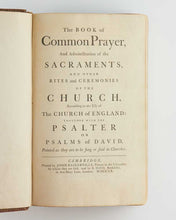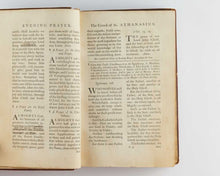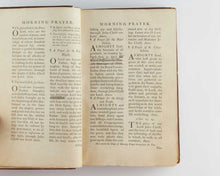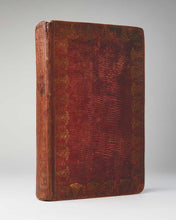
Updated in manuscript
[BASKERVILLE PRESS.] The Book of Common Prayer, And Administration of the Sacraments, and Other Rites and Ceremonies of the Church, According to the Use of The Church of England: Together with the Psalter or Psalms of David, Pointed as they are to be sung or said in Churches. Cambridge: John Baskerville, Printer to the University. 1760.
Large 8vo. Contemporary straight-grain red morocco, boards with elaborate gilt border of repeated scroll and flower head, flat spine gilt in compartments, edges gilt, marbled endpapers, red silk place-markers; unpaginated (signature: a-b8, c4, B-P8, Q6, r-y4, z2, R-2C8, 2D4, 2E2, 2F-2K4, 2L2; with cancels at a1, B7, C3 and C6), printed in two columns; spine and boards discoloured in parts with some soiling, extremities and corners a little worn, head of spine chipped (repaired), front hinge repaired, back hinge cracked but holding firm; price “seven shillings and six pence” rubbed away from title; occasionally very light toning and marginal dampstaining, closed tear to lower edge of C2 (not affecting text), but generally a very good, unusually clean copy; early 19th-century neat manuscript corrections to B6v, B7r, C3v, C6r-v, P4r (see below).
Second octavo edition of Baskerville’s Book of Common Prayer, this copy carefully updated throughout in manuscript following the accession to the throne of William IV in 1830.
This is the second of three octavo editions of the Book of Common Prayer printed by John Baskerville between 1760 and 1762. Issued in the same year as the first, it was modified to reflect the accession of George III on 25 October 1760 (B7, C3 and C6 were cancelled in order to alter the prayers for the Royal Family). It is, moreover, the only Baskerville edition in which the “occasional prayers” are consistently present. Of the known variants, this impression is distinguished by the absence of the “lozenge and star” border and by the use of roman type in the third line of the title.
Provenance: This copy remained in active use well into the nineteenth century. Following the accession of William IV on 26 June 1830, a conscientious reader revised the text throughout by hand, replacing “George” with “William” and altering prayers for “her Royal Highness the Princess Dowager of Wales” to refer instead to “Our Gracious Queen Adelaide”.
Gaskell 13; ESTC T81393.
#2122293







